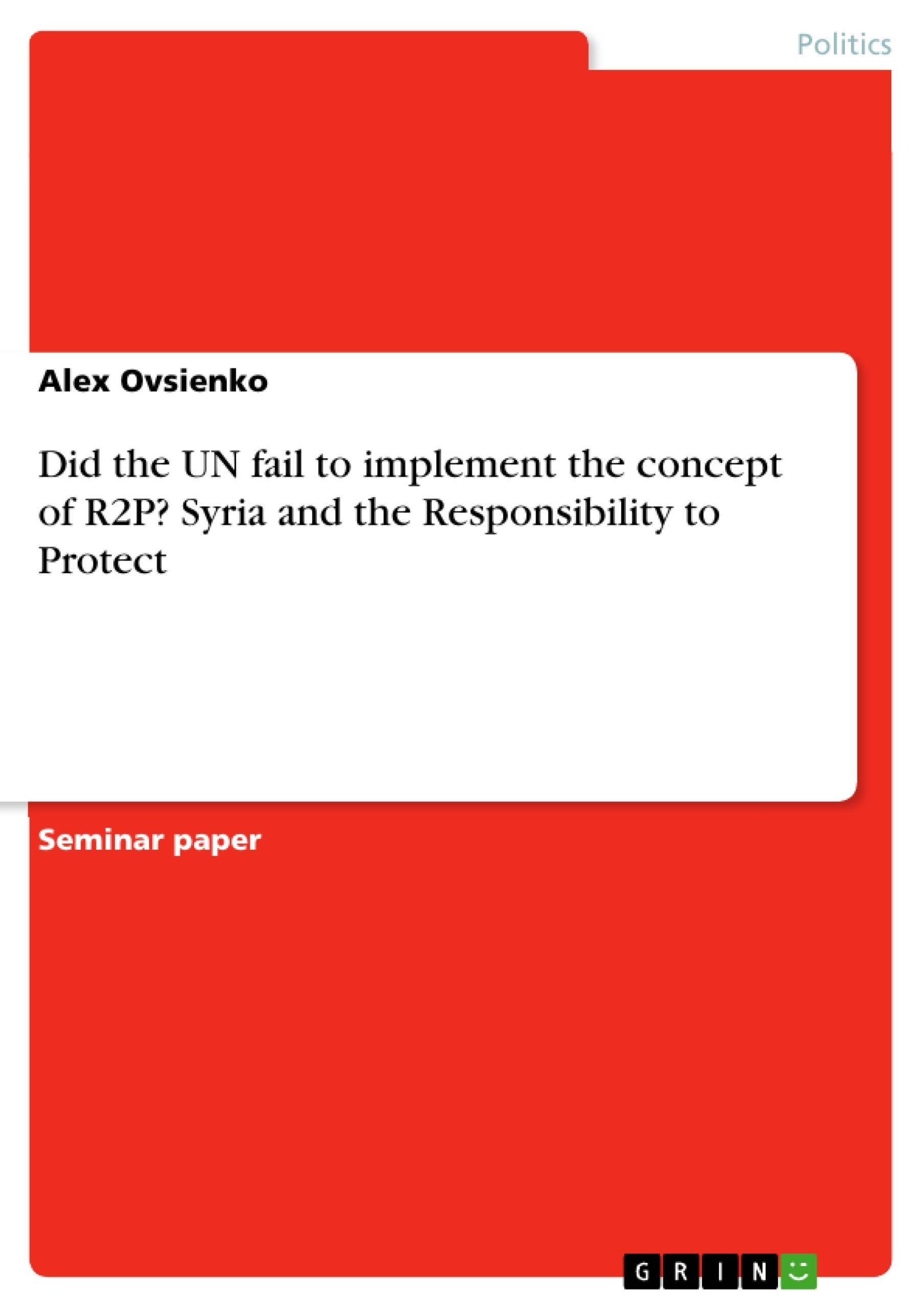In this paper I am going to find an answer to the question if the United Nations Security Council has failed to implement the concept of Responsibility to Protect regarding Syria.
In order to answer this query I will first take a look at the concept of the Responsibility to Protect its history and the main points of this concept. Furthermore I will look at the war in Syria, describe the main reasons and origin of this conflict.
Then I will try to find a response to the question whether the United Nations Security Council has failed its obligation to use the concept of Responsibility to Protect and get involved in this civil war. I will raise some controversial question whether like whether the failure of the United Nations Security Council to act on Syria means an end to the concept of R2P.
Inhaltsverzeichnis (Table of Contents)
- 1.0 Introduction
- 2.0 The concept of Responsibility to Protect
- 3.0 The History of the Responsibility to Protect
- 4.0 Deriving criteria for this paper
- 5.0 The Emergence of the Syrian Conflict
- 6.0 The Measures used by the International Community so far:
- 6.1 Responsibility to Prevent
- 6.2 The Responsibility to React
- 7.0 Conclusion
Zielsetzung und Themenschwerpunkte (Objectives and Key Themes)
This paper aims to analyze the United Nations Security Council’s response to the Syrian conflict in light of the Responsibility to Protect (R2P) doctrine. The paper will examine the history and core tenets of R2P, analyze the Syrian conflict’s origins and unfolding, and assess whether the UNSC has fulfilled its obligations under R2P.
- The concept of Responsibility to Protect (R2P)
- The Syrian conflict's origins and evolution
- The UN Security Council's response to the Syrian conflict
- The effectiveness of the R2P doctrine in addressing mass atrocities
- The implications of the UNSC's inaction in Syria for the future of R2P
Zusammenfassung der Kapitel (Chapter Summaries)
- 1.0 Introduction: This chapter sets the context for the paper by highlighting the Syrian conflict’s devastating impact and the international community’s failure to find a peaceful solution. It introduces the central research question: has the UN Security Council failed to implement R2P in Syria?
- 2.0 The concept of Responsibility to Protect: This chapter examines the R2P doctrine, outlining its principles and explaining its significance as a proposed norm for international intervention in cases of mass atrocities. It focuses on the three pillars of R2P: the responsibility to prevent, the responsibility to react, and the responsibility to rebuild.
- 3.0 The History of the Responsibility to Protect: This chapter delves into the historical development of R2P, tracing its origins in the aftermath of the Cold War and the increasing prevalence of internal conflicts. It explores how R2P emerged as a response to the shortcomings of existing international legal frameworks in addressing human rights violations within sovereign states.
- 4.0 Deriving criteria for this paper: This chapter defines the specific criteria and parameters used to evaluate the UNSC’s actions in Syria in relation to R2P. It lays out the key aspects of R2P that will be examined in the subsequent analysis of the Syrian case.
- 5.0 The Emergence of the Syrian Conflict: This chapter provides a comprehensive overview of the Syrian conflict, highlighting its root causes, key actors, and major events. It explores the complex dynamics and challenges facing the international community in addressing the conflict.
- 6.0 The Measures used by the International Community so far: This chapter analyzes the international community’s response to the Syrian conflict, focusing on the measures taken to implement the R2P principles. It examines the efforts made to prevent, react to, and rebuild in the Syrian context.
Schlüsselwörter (Keywords)
The primary keywords and focus topics include: Responsibility to Protect (R2P), Syrian conflict, mass atrocities, UN Security Council, humanitarian intervention, state sovereignty, international law, international relations, conflict resolution, peacebuilding, human rights violations, international community, peace and security.
- Citation du texte
- Alex Ovsienko (Auteur), 2016, Did the UN fail to implement the concept of R2P? Syria and the Responsibility to Protect, Munich, GRIN Verlag, https://www.grin.com/document/318425



